Nigeria faced hosts France in the third round of the FIFA Women’s World Cup group stages. The hosts had already secured a spot in the knockout stages, with wins over South Korea and Norway. This face-off was a good opportunity for the French boss Corinne Diacre to find a window of recovery for her top players in the midst of a competitive tournament packed with fixtures.
The Super Falcons from West Africa faced challenges beginning the tournament but proved indomitable against South Korea in Group A. They were still in pursuit of at least a point to put them in an advantageous position to qualify to the next round. Thus both teams had different objectives as they met at the Roazhon Park in Rennes.
In this tactical analysis, we examine how both teams played out to optimise their strengths and meet their objectives.
Lineups:
France: Bouhaddi, Perisset, Bathy, Renard, Majri, Henry, Thiney, Bilbault, Cascarino, Gauvin, Asseyi Subs: Durand, Torrent, Tounkara, Karchaoui, Geyoro, Le Sommer, Diani, Laurent, Bussaglia, Debever, Clemaron, Peyraud-Magnin
Nigeria: Nnadozie, Okeke, Ebi, Ohale, Ebere, Ayinde, Okobi, Chikwelu, Ordega, Oshoala, Oparanozie Subs: Oluehi, Okoronkwo, Nwabuoku, Imo, Uchendu, Kanu, Ajibade, Ihezuo, Ogebe, Chukwudi, Jonathan

Diacre gives non-regulars a chance
France, having effortlessly accomplished the first objective of progressing to the next stage, were already in preparation for the formidable opponents they would face in the knockout stages (Spain, United States or Sweden). It was necessary for Diacre to give his big guns, Eugénie Le Sommer and Kadidiatou Diani a deserved break. Élise Bussaglia who has been an engine in the midfield in the past two rounds of the group stages was exempted from the starting line-up against Nigeria.
This was an opportunity for the veteran, Gaëtane Thiney to step up to the challenge of leading the blues from the front and get the vital goals to see the game through. Diacre also chose Charlotte Bilbault to partner the captain, Amandine Henry in midfield. Marion Torrent, the attacking fullback who was unleashed potently against South Korea and Norway was rested in place of Eve Perisset.
The replacements made France look a lot less their threatening than their usual self, but they executed Diacre’s gameplan well. France played in a 4-4-2 with lots of interchanges involving the midfielders and forwards. They also occupied the width efficiently and exploited big gaps in the Nigerian team structure in attacking phases.
France play between the lines centrally
An attacking duo of Thiney and Valérie Gauvin is not your typical goal-scoring pair and are more suited in the midfield. We could see this in France’s attacking phase build-up. Thiney and Gauvin took turns to drop deeper between the lines of Nigerian pressure to receive and connect with the wide players. This movement worked well with a similar rotation coming from Bilbault and Henry in building up play from the centre-halves.
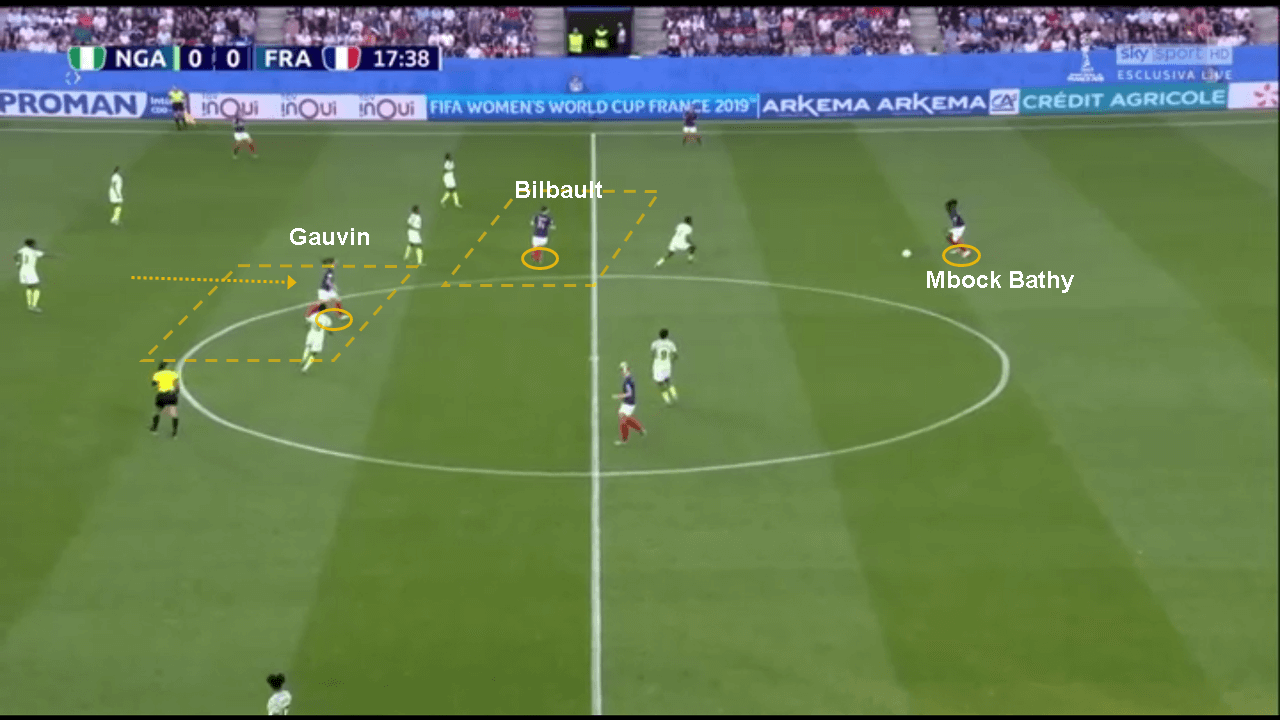
Nigeria, however, were able to work efficiently with their zonal 4-4-2 and neutralise France in the centre, forcing them to play wide. Viviane Asseyi worked intelligently inverting inside along with the forwards and overloading the centre as an extra player. Although France had numerical superiority in the crucial areas of the pitch, they weren’t able to translate this into attacking opportunities. In the first half, the hosts only managed six shots (five of them off target and one blocked) in comparison to 16 in the second half.
It was evident that Diacre’s strategy was to systematically open up the Nigerian defence rather than rely on the explosive counter-attack that has put the French on the front foot against South Korea and Norway. The effective passing in the centre also managed to isolate the two Nigerian forwards, Asisat Oshoala and Desire Oparanozie from the rest of the group.
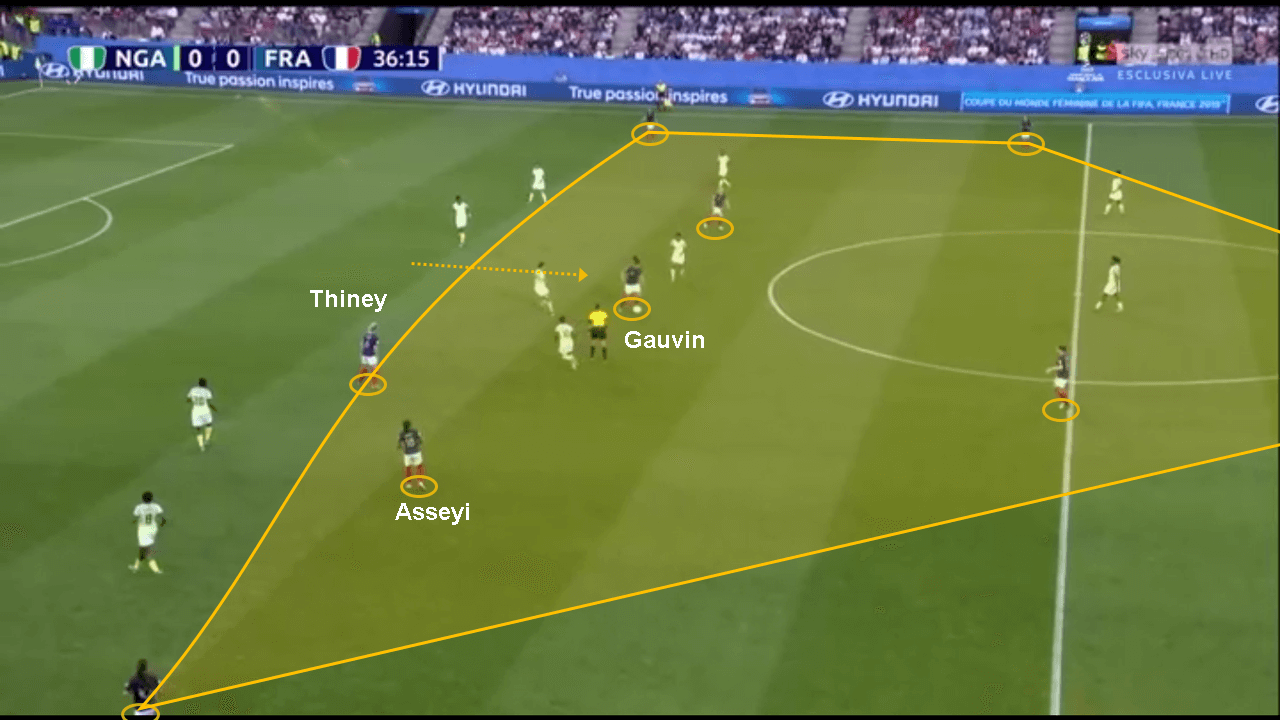
Nigeria – Defensive Organisation
Nigeria lined up in a 4-3-3 on paper but, in reality, they were a clear-cut 4-4-2. The right winger – Francisca Ordega would sit deep and join the midfield three of Halimatu Ayinde, Rita Chikwelu, and Ngozi Okobi. The two forwards Asisat Oshoala and Oparanozie would sit in the middle and initiate the press.
The two forwards marked either the two French centre-backs or the double pivot depending on the phase of ball-progression. Nigeria didn’t press high up the pitch. This is unlike their usual game-style; evidently, Thomas Dennerby decided to play in a more pragmatic manner – focusing on zonally protecting the space and ensure that the French midfielders – the likes of Amandine Henry – didn’t enjoy too much space in between the lines.

In essence, the match was a 4-4-2 versus a 4-4-2 – and this resulted in some very symmetrical ideas being on display. This resulted in many 1v1 situations all over the pitch. France played with high full-backs and wingers either drifting inside or staying wide to open up passing lanes. As can be seen above, to counter this, Nigeria had their own winger/wide midfielder press the full-back and the full-back move out to press the French winger.
Nigeria try to force their opponents to move out wide so that they can use the touchline and limit the options of the player on the ball. Incidentally, France also likes to use the width and stretch their opponents horizontally. Hence, it was crucial that Nigeria defended the wide overloads very well.
To achieve this and ensure that France weren’t able to find numerical overloads on the wing, Nigeria moved over their wide midfielder, the double pivot, as well as the forward to defend on the wings. As can be seen below, whenever France tried to combine on the wing, they were engaged by the Nigerian midfielders who moved over to neutralise the numerical superiority.

Nigeria’s counter-attacking
These wide engagements were not only a part of France’s game-plan but were also crucial to Nigeria’s offensive transitions. As can be seen above, Oshoala is in space and her teammates are aware of this. As soon as the ball is lost, she can be played in quickly or at least recycle possession and circulate the ball to the other side.
Nigeria didn’t get much of the ball during the entire match and hence, they adopted a fast vertical counter-attacking style. As soon as the ball was won in midfield, they tried to play the least number of passes and progress to the final third quickly. The plan was to take advantage of the spaces left behind by the advanced positions of France’s double pivot and hit them on the counter.

Nigeria, however, failed to capitalise on these scenarios properly. The French defenders were exceptional at recovering and some bad decision-making in the final third led to Nigeria not registering any shot on target in the first half.

With France playing with attacking full-backs, there were lots of spaces behind the French defence for Oshoala to attack but the rest of the midfield were not able to follow up in the attacking transition to help out.
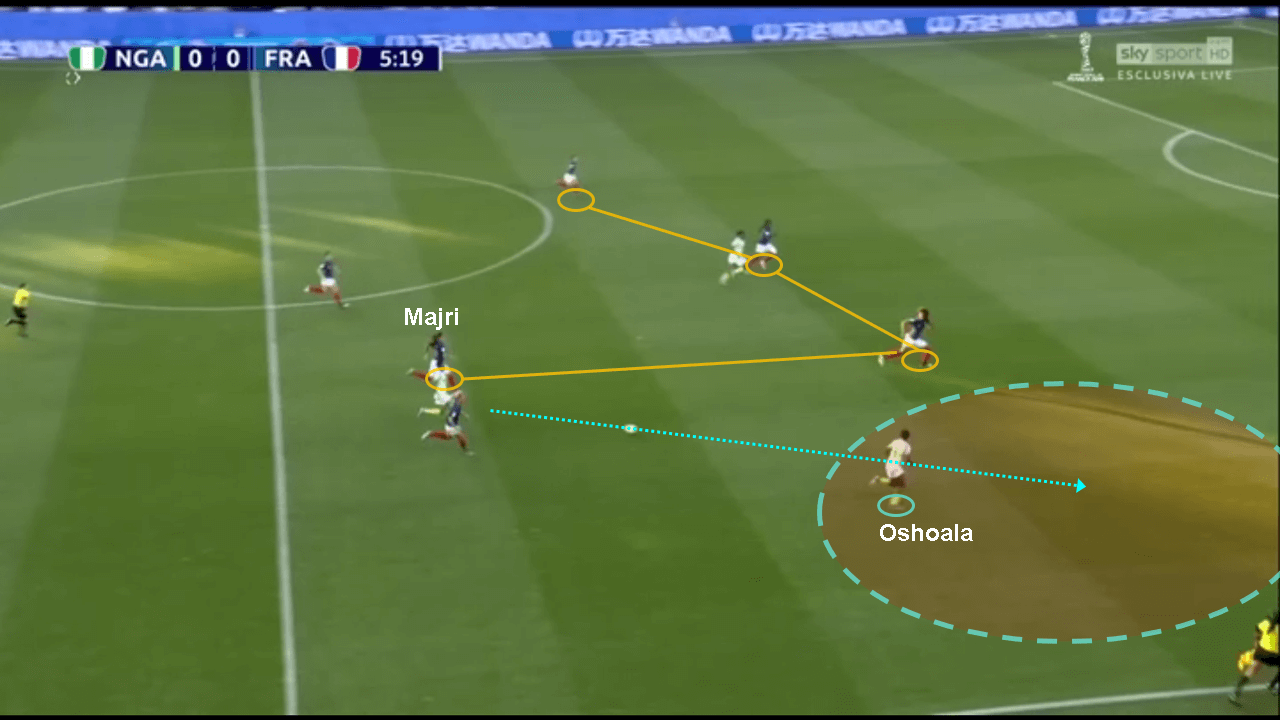
French combinations on the wings
‘Attack’ is the only word one can associate with the French full-back Amel Majri who dons the number 10 jersey. It was clear from the start of the tournament that she thrives in wide open spaces on the flanks against the opposition. As predicted, France looked to exploit the wide areas with Majri. In this game, she paired up with Asseyi on the left wing to create problems for Nigeria.
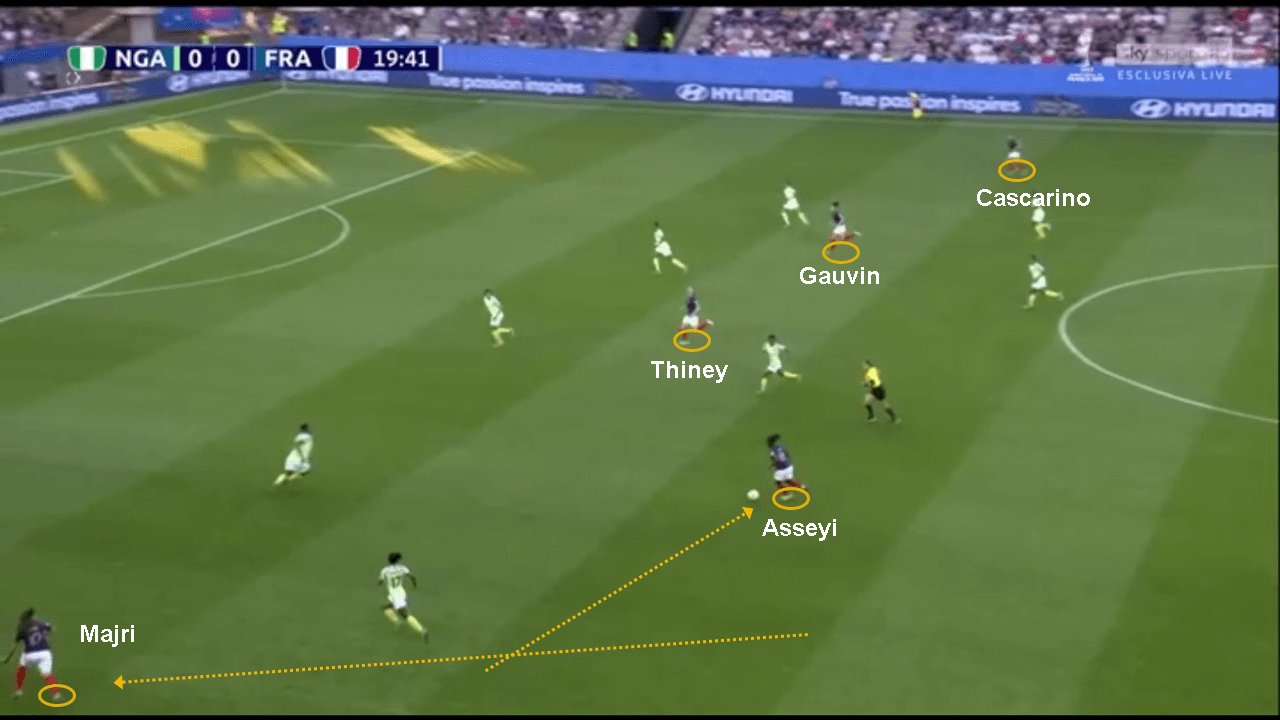
Majri always looked to overlap Asseyi even before Renard was settled on the ball and was often found putting a lot of pressure on Chidinma Okeke and Halimatu Ayinde. Asseyi would pick opportunities to either stay wide and allow Majri to attack the half space on the left or drift inside so that Majri remained high up as a typical left winger.
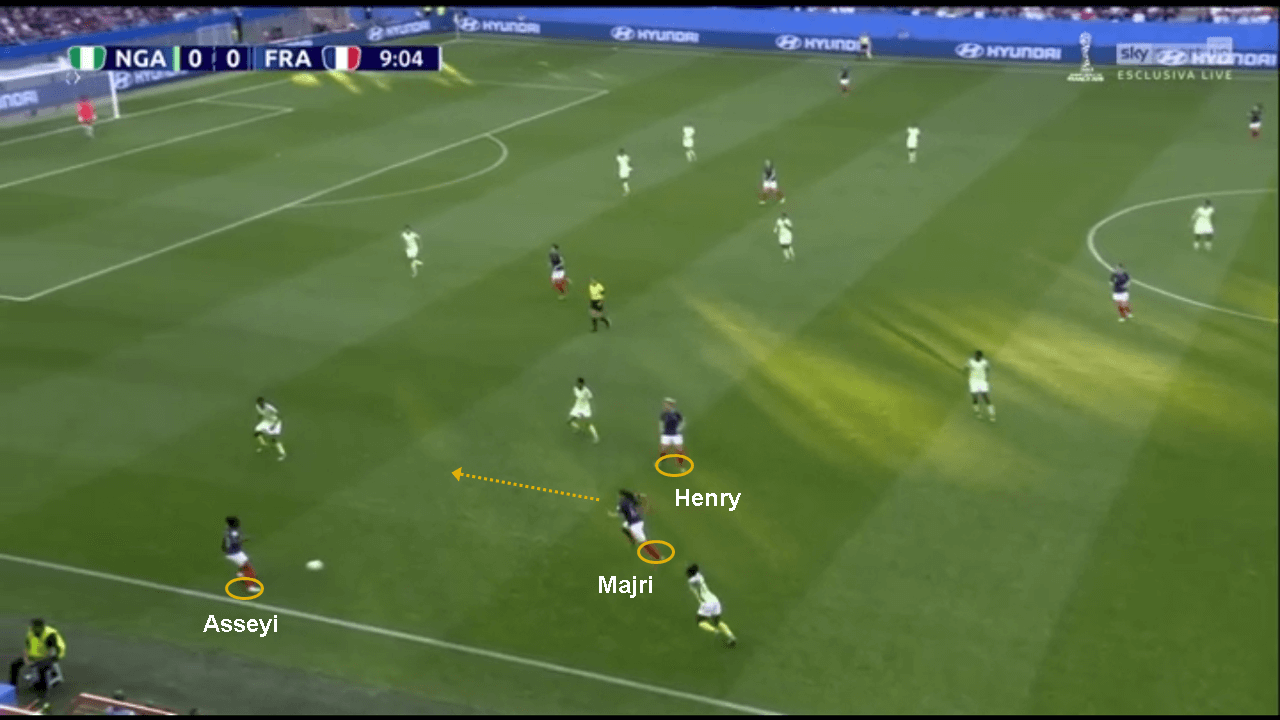
Although this combination play proved effective and deadly for France, they weren’t able to create many shots on goal through Thiney and Gauvin. 20 minutes into the first half, Diacre’s team was able to recognise Ngozi Ebere having a nervous day against the likes of the technically gifted Delphine Cascarino. Thus, they shifted the focus of the attack to the right for the rest of the game, which worked out brilliantly for them.
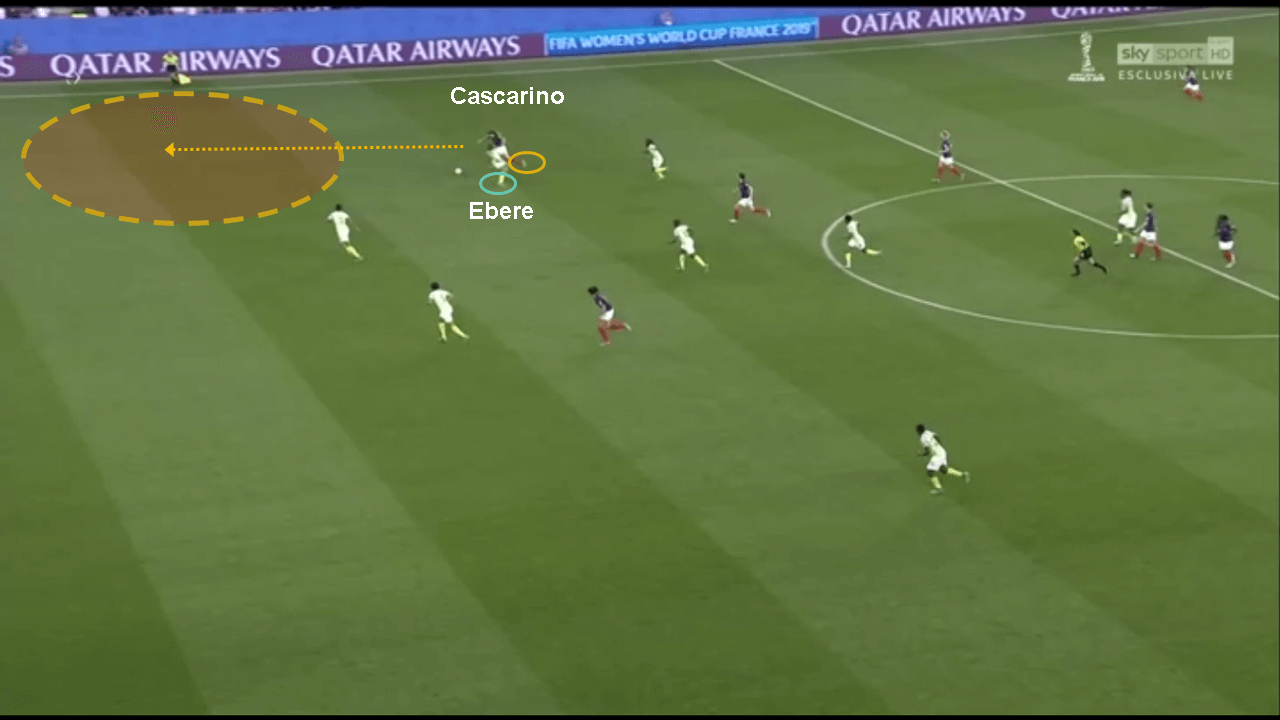
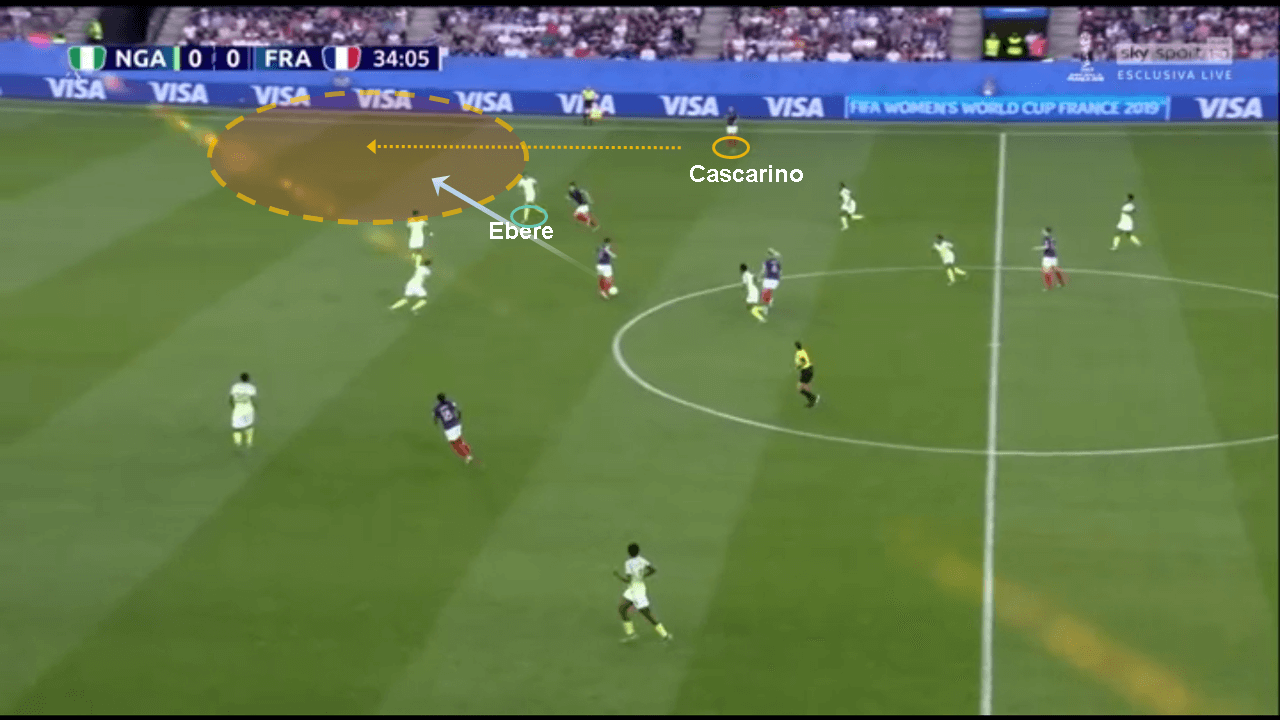
After Le Sommer and Diani were brought on, Asseyi moved to the right wing and continued to offer a similar threat. She was hands down the POTM for her intelligent positioning and play-making ability and could be easily considered by Diacre to partner the big stars in crucial fixtures ahead.
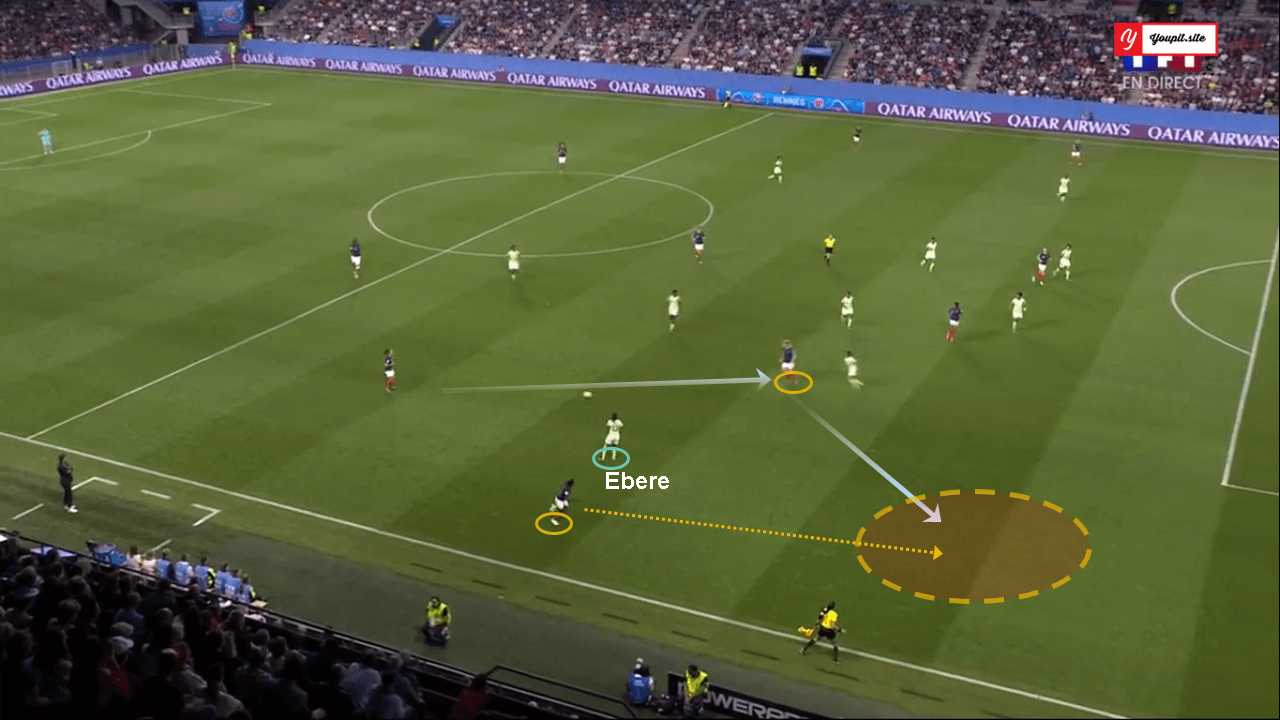
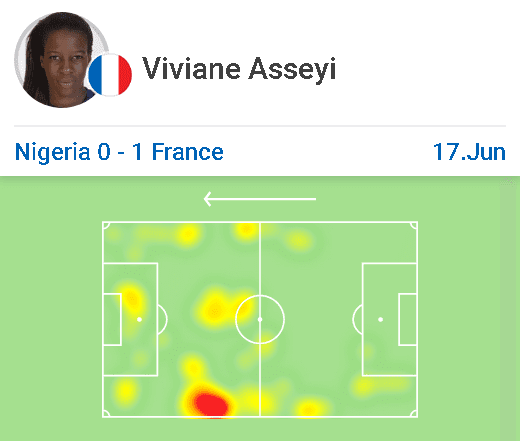
VAR and new rules dramatically settle the score
After an hour of the French unable to break through the steadfast Nigerian defence, Diacre warmed up and brought in the heavy artillery, Le Sommer and Diani, at the same time. However, it was VAR that had to intervene (yet again) to push the hosts ahead of the West Africans. The introduction of Le Sommer dramatically changed the attacking game for France. In a particular moment, it was Ebere again who found herself extremely misfortunate to pick up a second yellow and leave the 18-year-old keeper Chiamaka Nnadozie at the mercy of a French penalty against Wendie Renard.
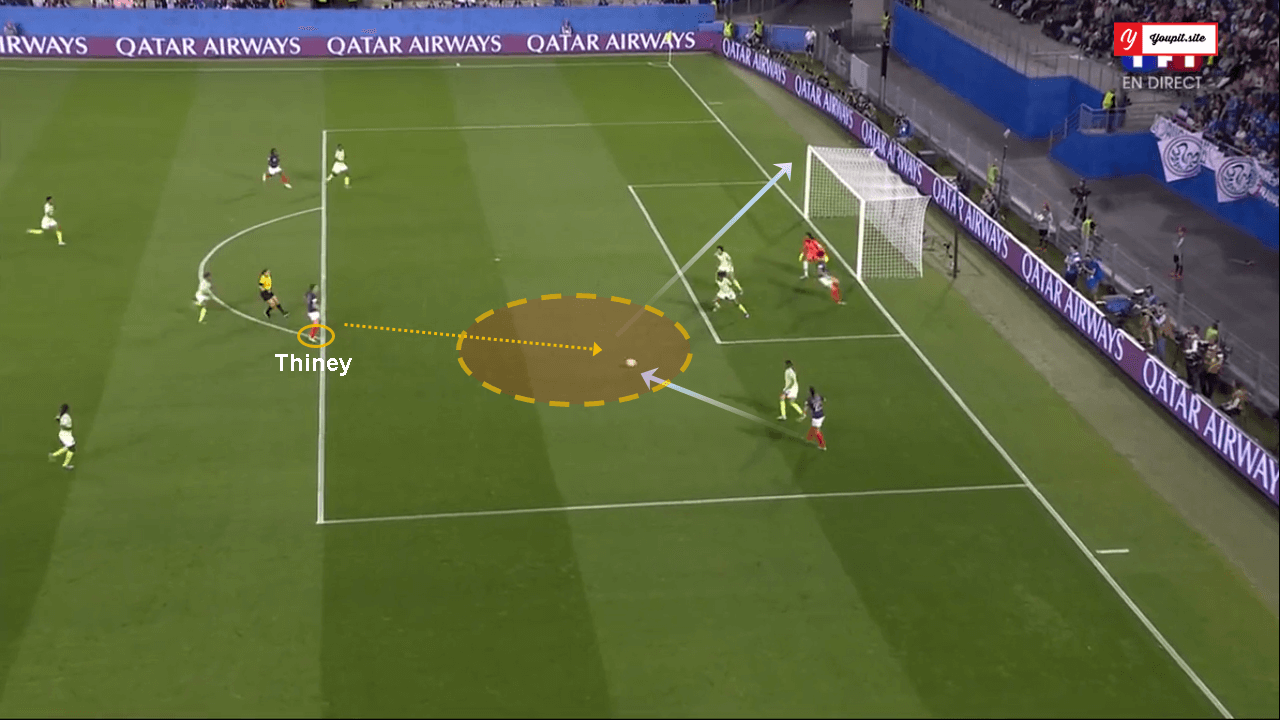
Although Renard completely missed the first penalty, it had to be retaken due to changes in the rule about the keeper having at least one foot on the goal line. Renard was able to salvage her reputation after two grave errors in this tournament. The goal stood as the only thing to separate the two sides until the final whistle. It was arguably harsh on the young Nigerian keeper who correctly predicted Renard’s direction in both the penalties and put together some lightning reflex saves to keep the French frustrated throughout the game.
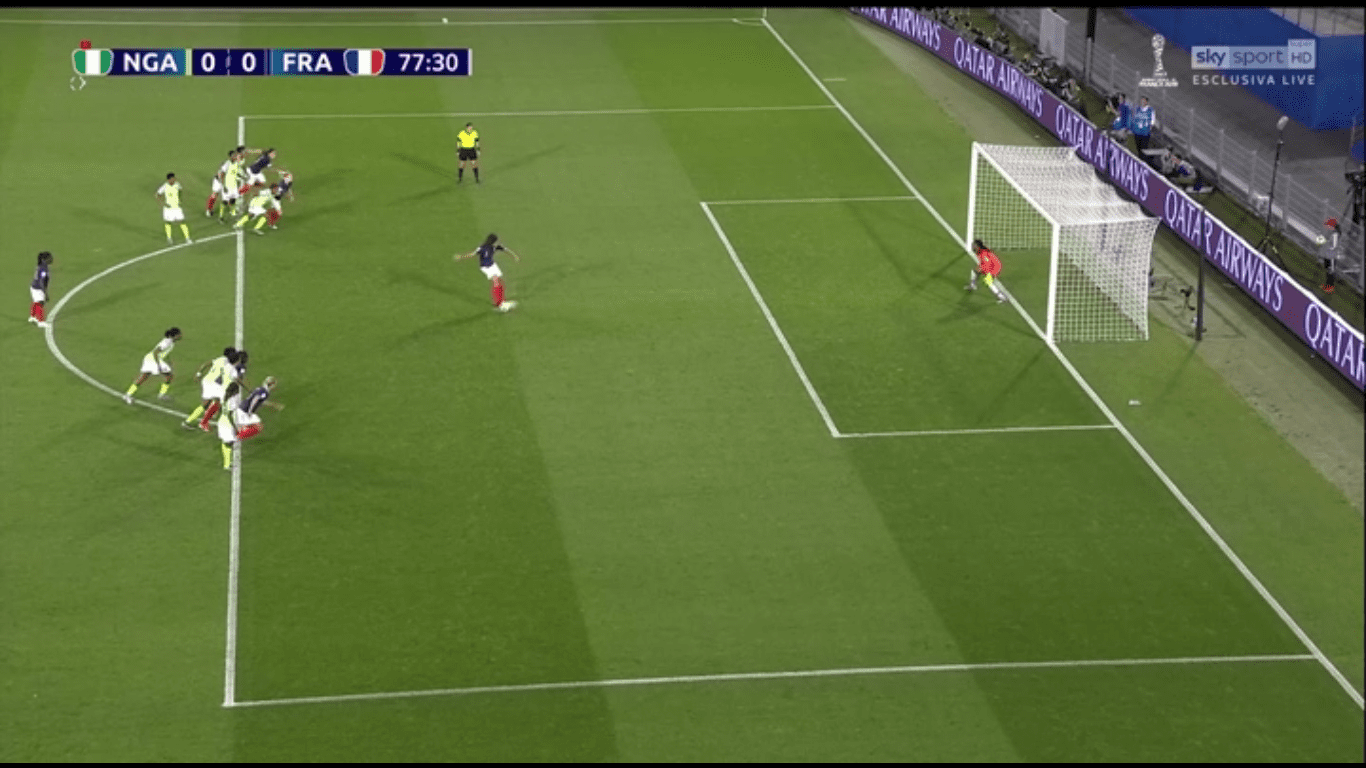
Thomas Dennerby was also vocal about his dissent after the game:
“I am disappointed with the result. France is a really good team and does not need support from anybody to win games.
“I feel so sorry because the girls were fighting so well and followed the match plan but it’s getting destroyed by people. Of course, we are not happy.”
Looking at how effectively Nigeria managed to contain France tactically in this analysis, even until the end with 10 players against the likes of Le Sommer, Diani, Majri and Asseyi, it is easy to see how Dennerby’s strategy to push for the crucial point against a bigger team like France did pay off well.
Conclusion
The top four out of the 3rd place finishers in the groups progress to the knockout stages. Therefore, the Super Falcons will have to wait for the results from the other groups to know how long their journey in the World cup will continue. Although they deserved a vital point in this game, they will have to pray that the two goals against South Korea will suffice against the likes of other competitive teams.
Nonetheless, Nigeria have all the reasons to hold their heads high after this game. Considering the premises of both teams, France have most of their squad that plays for Champions league winners, Olympique Lyonnais and have undergone a rigorous preparation at the Clairefontaine prior to the tournament. Nigeria, on the other hand, have only recently been able to put together their squad under Dennerby and did not play a single game of football for the whole of 2017!
Diacre has serious homework to do as France marches on. They are susceptible to effective pressing as seen against Norway and now Nigeria. They are also very dependant on playing through the wide areas with their best players preferring to attack from out wide. This goal was a huge boost for Wendie Renard, but she has been error-prone this tournament and will have to rectify immediately before France are put up against bigger opponents.
If you are following the FIFA Women’s World Cup 2019 then you will find our FREE tactical preview magazine the perfect compliment to the tournament. You can download it HERE – each nation is previewed and we also profile their key player and young player to watch. Enjoy!

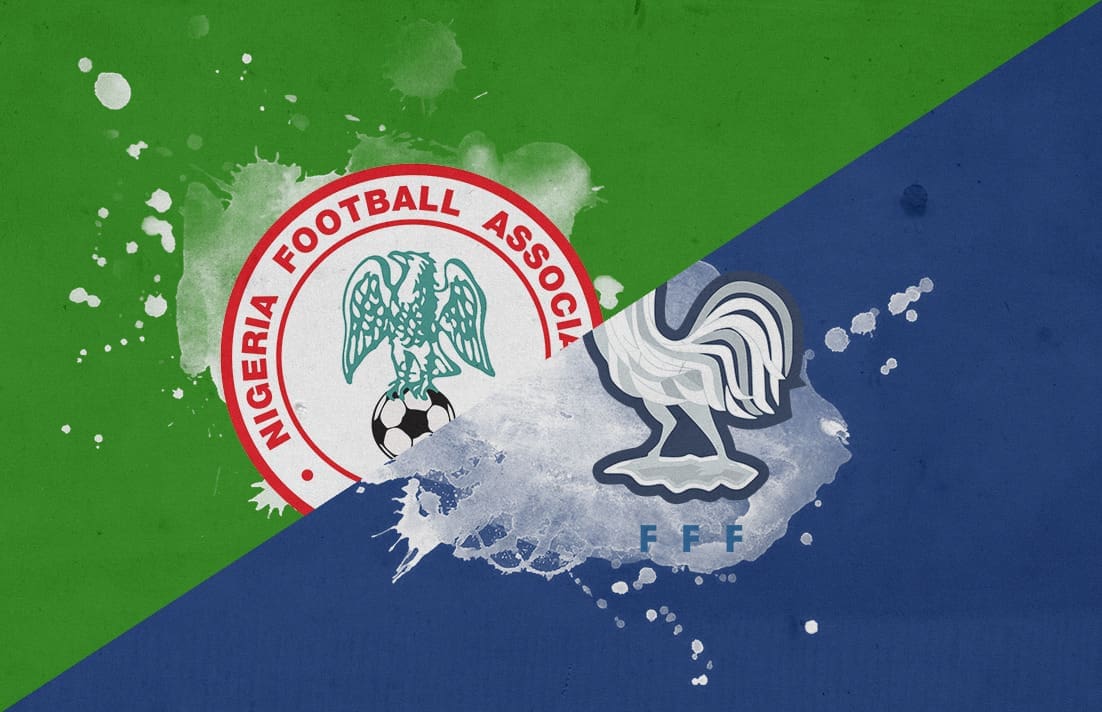


Comments